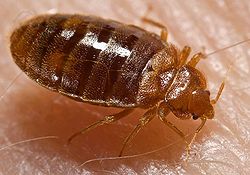
Bed Bugs Petri Dish
Not only are they dorsoventrally flattened, but they are also thin which creates a great advantage for them. They can hide in unusual places such as behind baseboards, floor cracks, and under carpets or behind loose wallpaper, which makes them difficult to detect.
Their bites leave itchy, welts on the skin and can cause allergic reactions such as severe blisters, burning and itching.
Bed bugs have existed since the ancient times and are found in temperate climates throughout the world. There are different types of bed bugs, but their favorite source of nutrition is human blood.
In tropical regions, including Florida, another visible kind of species called Cimex hemipterus, are also known to swarm among poultry and bats. Other places, such as West Africa and South America, are home to the Leptocimex boueti species that infests bats and humans. On the other hand, the species that are found among bats are called Cimex pilosellus and C. pipistrella, and are lurking all over in North America, primarily in poultry farms.
Since they can survive in birds’ nests, they can be seen in houses and buildings that have several bird nests, particularly on rooftops. They are also known to feed on bats or household pets, but their typical source of nutrition is human blood.
Bed bugs have a great worldwide distribution due to human travelers who transport luggage, clothing, bedding, and furniture. Though they may reside in unusual places, they are also likely to be found in small cracks near a bed or in comforters and bed sheets.
How To Get Rid of Bed Bugs:
It’s possible to pick up bed bugs almost any place – they’ve infested offices, stores, hotels, gyms and countless other places we never would have imagined just 10 years ago. They can hide in your luggage, personal belongings, or even on you, and hitchhike a ride back to your home. Once indoors, they can be extremely difficult to eradicate without the help of an experienced pest control professional.
A bed bug infestation has nothing to do with cleanliness – you can pick them up in even the finest hotels, and they can hitchhike into the cleanest homes at any time. But, you can help reduce your chances of a costly bed bug infestation by catching them early.
Traveling
When traveling, think of the acronym S.L.E.E.P. to remember the following action steps to help avoid taking bed bugs home with you.
- Survey surfaces for signs of an infestation, such as tiny rust-colored spots on bed sheets, mattress tags and seams, and bed skirts.
- Lift and look for all bed bug hiding spots, including underneath the mattress, bed frame, headboard, and furniture. Typically, they come out at night to feed, but during the day, they are most likely found within a 5-foot radius of the bed.
- Elevate your luggage on a luggage rack away from the bed and wall, since bed bugs can often hide behind head boards, artwork, picture frames and electrical outlet panels.
- Examine your luggage carefully while repacking and when you return home. Always keep luggage off the bed and store it in a closet or other area, far away from your bedroom.
- Place all your clothing from your luggage immediately in the dryer for at least 15 minutes at the highest setting upon returning home from travel.
- In the House, when at home, follow these handy tips to help keep bed bugs at bay.
- Remove all clutter from your home. This makes finding bed bugs easier.
- Wash and dry your bed linens often using the hottest temperature allowed for the fabric.
- Closely inspect any second-hand furniture for bed bugs before you bring it into your residence.
- Inspect your residence regularly, especially after a move in, a trip, a visit from a service worker or overnight guest.Think You Might Have a Bed Bug Infestation?
- Notify Atlas pest control immediately, or tell your property manager if you are renting. Bed bugs can multiply quickly so early detection is critical to help prevent an even larger infestation.
